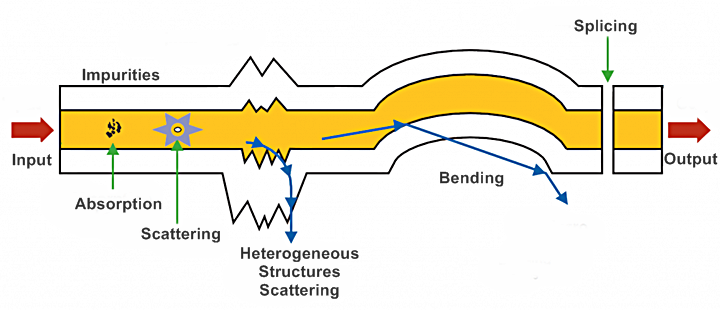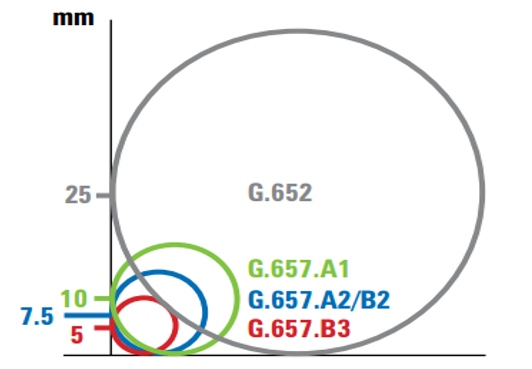Optical fibers have become very popular because they are fast and durable. However, there are several challenges for optical fiber installations. The primary one is cost: both for installation and purchasing. In addition, you may experience transmission loss in optical fibers, but the losses are far from those in copper cables. Moreover, research in optical fibers has introduced several superior models that aim to reduce these losses, for example, G652D A1 fibers and G657A2 fibers.
Contents
Types of Transmission Losses

Source: Transmission Losses
The primary source of transmission loss include contaminations, attenuation, dispersion, bending, and connection-related. You can read about them in this article:
- Contamination Loss: Primary transmission loss in optical fibers occurs due to contamination of the end faces of optical fibers. The dirt, oil, etc., can block the light signals from traveling from one end of the copper wire to the other. The situation can reduce bandwidth and may even disable the entire transmission.
- Attenuation: Attention refers to the decrease in amplitude of the signal; the unavoidable absorption and scattering remain the primary cause of attenuation. You usually measure attenuation in dB/km. In absorption, the impurities present in the optical fibers convert the light signal to heat. Hydroxyl ions are the usual impurities. In scattering, the light deviates from its path after striking small particles or due to imperfections in the fiber. As a result, attenuation reduces with the wavelength of the transferred light.
- Dispersion: Signals spread out as they travel through the optical fiber; it can be because of the difference in the speeds of the modes and the number of different frequencies. In an LED, the dispersion will be more as it contains more individual frequencies than a laser.
- Bending: Bending loss can happen for two
reasons:
- Macro bending: This means the bending is visible to the naked eye. For example, for fiber deployment, you may have to bend the fiber cables several times to fit them in a closed space or deliver the fiber from one room to another. Such bending can cause light to leak, reducing the signal quality.
- Micro bending: Optical fibers may have micro bends formed in manufacturing; these can also cause the light to reflect at angles that terminate further propagation.
- Connectors: You can lose signal quality while transmitting, even due to the connectors. A connection is an interface; light has to travel from one medium to other. And this transfer always results in some loss due to back reflection. In addition, misalignment and spliced connectors can also cause significant losses.
Fibers to Minimize The Transmission Losses
These transmission losses significantly reduce the quality of service. In addition, with the advancement of technologies like IoT, 5G, edge computing, and cloud computing, demand for high-speed data transmission is rising. So industries must be careful during fiber deployments to minimize the loss.
From the definitions of transmission losses, you can see that losses due to dispersion, bending, absorption, and scattering are characteristics of optical fibers. Hence, you can minimize these transmission losses by choosing suitable fibers. So below, you can read two optical fiber specifications by the ITU-T that minimize this transmission.
G652 Fibres
G652 fibers are single-mode optical fibers with zero dispersion around the wavelength of 1310 nm, but you can also use them in the 1550 nm region. These fibers have four categories: A, B, C, and D. And the G652D fiber is the most popular because of its better characteristics. Therefore, most manufacturers prefer G652D fibers for making optical fiber cables.
G652D improves upon others in optical signal attenuation, transmission non-linearity, and polarization mode dispersion. Each of the characteristics affects the signal strength.
Except for the G652A Fibres, the macro-bending loss of G652 fibers is less than 0.5 dB at 1625 nm; G652A has a macro-bending loss of less than 0.5 dB at 1550 nm.
Reducing macro bend loss is crucial in tight spaces and long ranges deployments. Tight space deployments require the fiber to bend several times to fit in a confined space, so a higher macro bend loss will significantly reduce the light quality. Similarly, in long-range deployments, you need optical amplifiers every 50 km to 80 km; however, near each amplifier, you must leave some extra buffer fiber as coils. You need this buffer for slight adjustments in length. But these coils become the source of macro-bend loss. So again, a low macro-bend loss fiber is necessary for reducing transmission loss.
Other advantages of G.652.D fibers are:
- Low water peaks: These fibers have less amount of other molecules that absorb and weaken the signal.
- Excellent PMD performance: Different polarizations can have different speeds in optical fibers. The higher the speed difference, the greater the signal spread and attenuation.

Source: Bending Radii of various fiber types
G657 Fibres
The G657 cables are superior to the G652 optical cables in bend loss and radius. They are more flexible, and you can quickly deploy them in streets, buildings, and homes. Fiber cables reduce the deployment cost because of their increased flexibility, smaller cabinets, pedestals, enclosures, and terminations.
They have two main groups: A and B.
Fibers are for access networks, and B fibers are for short-distance networks. Each group has sub-categories:
- G657.A1 and G657A2 fibres
- G657B2 and G.657B3 fibres
These categories have different bending radii: G.657.B3 has the lowest bend radius (5 mm), meaning you can use it in tiny spaces. G657A1 fibers have the highest bend radius (10 mm). However, compared to the G652D A1 fibers can fit in smaller spaces. The G.657.A1 fibers also show a slightly higher zero-dispersion range from 1302 nm to 1324 nm, while the dispersion range is only up to 1322 nm for G.652.D fibers.
G657 A2 fibers and G657 A1 fibers have a higher bend radius than G657 B3 fibers; however, industries prefer the G657A2 fibers more because of their compatibility with popular G652D fibers.
In conclusion, avoiding transmission losses in optical fibers is crucial for efficient communication. Several reasons exist for transmission loss, dirty end faces, lousy connections, attenuation, bending losses, and dispersion. However, choosing suitable fibers can ensure minimum transmission losses due to attenuation, ablation, and distribution. G652D fibers and G657A2 fibers remain the industry’s favorites because of their reduced transmission losses and interoperability. AmongG657A1, G657A2, and G652D, A1 fibers, and A2 fibers have a lower bend radius, making them useful in regions with space restrictions, like homes or offices. Overall, G657A2 fibers are preferable because they are interoperable with G652D; A1 fibers have a higher bend radius than A2 fibers.












